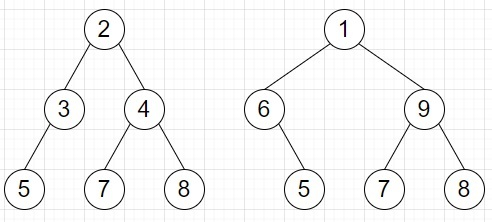
 Data Structure
Data Structure Networking
Networking RDBMS
RDBMS Operating System
Operating System Java
Java MS Excel
MS Excel iOS
iOS HTML
HTML CSS
CSS Android
Android Python
Python C Programming
C Programming C++
C++ C#
C# MongoDB
MongoDB MySQL
MySQL Javascript
Javascript PHP
PHP
- Selected Reading
- UPSC IAS Exams Notes
- Developer's Best Practices
- Questions and Answers
- Effective Resume Writing
- HR Interview Questions
- Computer Glossary
- Who is Who
Check if leaf traversal of two Binary Trees is same in Python
Suppose we have two binary tree. We have to check whether leaf traversal of these two trees are same or not. As we know the leaf traversal is sequence of leaves traversed from left to right.
So, if the input is like

then the output will be True as the left traversal sequence of both of the trees are same, that is [5, 7, 8].
To solve this, we will follow these steps −
- s1 := a new list, s2 := another new list
- insert r1 into s1 and r2 into s2
- while s1 and s2 are not empty, do
- if s1 is empty or s2 is empty, then
- return False
- r1_node := last node of s1, and delete it from s1
- while r1_node is not same as null and r1_node is not leaf, do
- if right of r1_node is not same as null, then
- insert right of r1_node at the end of s1
- if left of r1_node is not same as null, then
- insert left of r1_node at the end of s1
- r1_node := last node of s1, and delete it from s1
- if right of r1_node is not same as null, then
- r2_node := last node of s2, and delete it from s2
- while r2_node is not null and r2_node is not leaf, do
- if right of r2_node is not null, then
- insert right of r2_node at the end of s2
- if left of r2_node is not null, then
- insert left of r2_node at the end of s2
- r2_node := last node of s2, and delete it from s2
- if right of r2_node is not null, then
- if r1_node is null and r2_node is not null, then
- return False
- if r1_node is not null and r2_node is null, then
- return False
- if r1_node and r2_node both are not null, then
- if value of r1_node is not same as value of r2_node, then
- return False
- if value of r1_node is not same as value of r2_node, then
- if s1 is empty or s2 is empty, then
- return True
Example
Let us see the following implementation to get better understanding −
class TreeNode: def __init__(self, x): self.val = x self.left = self.right = None def is_leaf(self): return self.left == None and self.right == None def solve(r1, r2): s1 = [] s2 = [] s1.append(r1) s2.append(r2) while len(s1) != 0 or len(s2) != 0: if len(s1) == 0 or len(s2) == 0: return False r1_node = s1.pop(-1) while r1_node != None and not r1_node.is_leaf(): if r1_node.right != None: s1.append(r1_node.right) if r1_node.left != None: s1.append(r1_node.left) r1_node = s1.pop(-1) r2_node = s2.pop(-1) while r2_node != None and not r2_node.is_leaf(): if r2_node.right != None: s2.append(r2_node.right) if r2_node.left != None: s2.append(r2_node.left) r2_node = s2.pop(-1) if r1_node == None and r2_node != None: return False if r1_node != None and r2_node == None: return False if r1_node != None and r2_node != None: if r1_node.val != r2_node.val: return False return True root1 = TreeNode(2) root1.left = TreeNode(3) root1.right = TreeNode(4) root1.left.left = TreeNode(5) root1.right.left = TreeNode(7) root1.right.right = TreeNode(8) root2 = TreeNode(1) root2.left = TreeNode(6) root2.right = TreeNode(9) root2.left.right = TreeNode(5) root2.right.left = TreeNode(7) root2.right.right = TreeNode(8) print(solve(root1, root2))
Input
root1 = TreeNode(2) root1.left = TreeNode(3) root1.right = TreeNode(4) root1.left.left = TreeNode(5) root1.right.left = TreeNode(7) root1.right.right = TreeNode(8) root2 = TreeNode(1) root2.left = TreeNode(6) root2.right = TreeNode(9) root2.left.right = TreeNode(5) root2.right.left = TreeNode(7) root2.right.right = TreeNode(8)
Output
True

Advertisements
